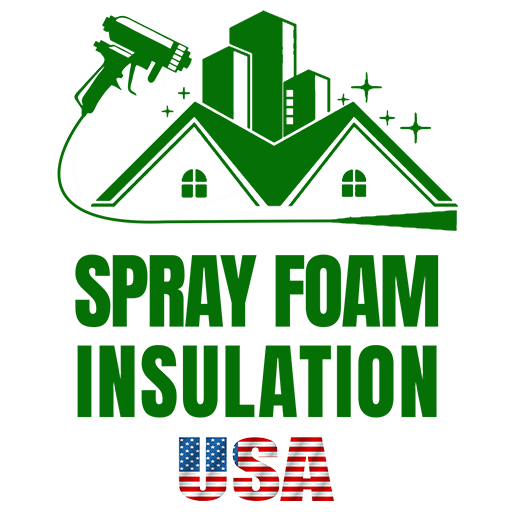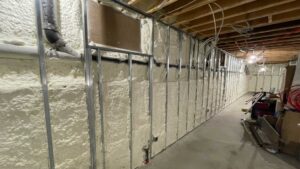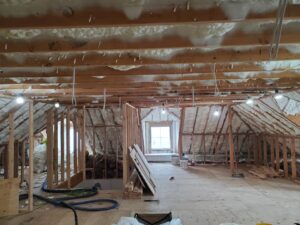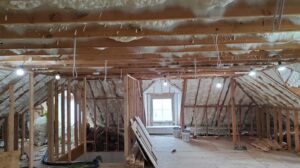When you’re in the market for commercial insulation, it’s crucial to understand your options to make the best choice for your business. Briefly, the primary types of commercial insulation include fiberglass, cellulose, spray foam, and rigid foam board. Each has its own advantages in terms of R-value (a measure of thermal resistance), air sealing capabilities, and overall performance in energy efficiency.
Energy efficiency isn’t just an environmental concern—it’s also about reducing operational costs and enhancing the comfort of your building year-round. Proper insulation acts as a barrier against heat loss in the winter and heat gain in the summer. By choosing the right insulation, businesses in NY and NJ can significantly lower their energy bills, provide a more comfortable environment for employees and customers, and contribute to a more sustainable planet.

Understanding insulation and its importance goes beyond just picking a material. It involves recognizing how the right insulation affects energy consumption, indoor air quality, and even the longevity of your HVAC systems. With this guide, we aim to simplify the complexity of commercial insulation options, helping you make an informed decision that aligns with your energy efficiency goals and sustainability values.
Types of Commercial Insulation
When considering insulation for commercial buildings, it’s crucial to understand the different materials available and how they can best serve your needs. Let’s dive into the four primary types of commercial insulation: Fiberglass, Cellulose, Foam, and Mineral Wool.
Fiberglass Insulation
Fiberglass is a widely used insulation material, made from fine glass fibers. It’s affordable and effective, making it a popular choice for many commercial projects.
- Pros: Cost-effective, easy to install, non-flammable.
- Cons: Less effective at blocking air flow compared to other options. Requires protective gear during installation due to tiny glass particles.
Cellulose Insulation
Cellulose insulation is made from recycled paper products, mainly newspaper, treated with fire retardants. It’s an eco-friendly option that provides excellent thermal performance.
- Pros: High R-value, great for air sealing, environmentally friendly.
- Cons: Can settle over time, reducing effectiveness. Requires professional installation for best results.
Foam Insulation
Foam insulation includes two main types: spray foam (open cell and closed cell) and rigid foam boards. It expands to fill gaps, offering superior air sealing capabilities.
- Spray Foam Pros: Excellent air barrier, fills irregular spaces, high R-value.
- Spray Foam Cons: Higher cost, professional installation required, potential for off-gassing.
- Rigid Foam Pros: Great for exterior wall applications, high R-value per inch, moisture resistant.
- Rigid Foam Cons: Can be more expensive than other options, requires careful installation to avoid gaps.
Mineral Wool Insulation
Also known as rock wool or slag wool, mineral wool insulation is made from natural or industrial minerals. It offers excellent fire resistance and soundproofing capabilities.
- Pros: Fire-resistant, effective sound barrier, does not require additional fire retardants.
- Cons: Can be more expensive than fiberglass, heavier, making installation more challenging.

Selecting the right insulation material for your commercial building involves considering several factors:
- Climate: The local climate plays a significant role in determining the type of insulation that will be most effective. Colder climates might benefit more from materials with higher R-values, like foam insulation.
- Building Design: The design of the building can also influence the choice of insulation. For example, buildings with irregular shapes or hard-to-reach areas might be better suited to spray foam insulation.
- Sustainability Goals: For businesses prioritizing sustainability, cellulose or mineral wool might be preferred due to their eco-friendly properties.
- Budget: Cost is always a consideration. Fiberglass tends to be the most budget-friendly option, but the long-term energy savings of more expensive materials like foam insulation can offset the initial investment.
In the next section, we’ll explore how to evaluate these materials based on their thermal performance, R-value, and other critical factors to help you make the best choice for your commercial insulation needs.
Evaluating Insulation Materials
When selecting insulation for commercial projects, understanding the performance and properties of different materials is crucial. Let’s break down the key factors:
Thermal Performance and R-value
R-value measures how well an insulation material can resist heat flow. Higher R-values mean better insulation and energy efficiency. For example, spray foam insulation often provides a higher R-value per inch compared to traditional materials like fiberglass or cellulose, making it an excellent choice for spaces where maximizing insulation in minimal space is essential.
Air Filtration
Air sealing is as important as the insulation material itself. Materials like spray foam excel in this area by creating a tight seal that minimizes air leaks, effectively reducing energy costs and improving indoor air quality.
UV Stability
Not all insulation materials can withstand UV exposure without degrading. Fiberglass and mineral wool are UV stable, maintaining their insulating properties over time. In contrast, spray foam requires additional protection if exposed to sunlight, as UV rays can compromise its effectiveness.
Sound Insulation
Creating a quiet and comfortable environment is vital. Fiberglass and mineral wool insulation offer excellent sound dampening properties, making them ideal choices for reducing noise transfer between rooms or from outside sources.
Fire Protection
Safety cannot be overlooked. Fiberglass and mineral wool are non-combustible, providing an added layer of fire resistance. Spray foam insulation, while not inherently fireproof, can be treated with fire retardants to meet safety standards. Cellulose insulation, despite being treated with fire retardants, still presents a higher risk compared to non-combustible options.
Health Impacts
Consider the health implications of insulation materials. Fiberglass and mineral wool have come a long way in reducing irritation and improving indoor air quality. Spray foam, when properly installed, seals off potential air leaks but requires careful handling and installation to prevent exposure to chemicals.
Moisture and Mold
Protecting against moisture and mold is essential for maintaining a healthy building environment. Materials like closed-cell spray foam act as a vapor barrier, helping to prevent moisture buildup that can lead to mold growth. In contrast, materials that absorb moisture, like cellulose, may require additional measures to manage moisture effectively.
Sustainability
Eco-friendliness is increasingly important. Materials like cellulose are made from recycled paper, making them a more sustainable choice. Spray foam options that use eco-friendly materials, such as soy-based products, offer a greener alternative to traditional petroleum-based foams.
Choosing the right insulation material involves balancing thermal performance, air sealing capabilities, fire safety, health considerations, and environmental impact. Whether it’s the high R-value and air sealing benefits of spray foam or the fire resistance and sound insulation of mineral wool, each material offers unique advantages. By carefully evaluating these factors, you can select the insulation that best meets the needs of your commercial project, ensuring energy efficiency, safety, and comfort for years to come.
Cost Considerations for Commercial Insulation
When planning for commercial insulation, understanding the cost factors is crucial. Let’s break down the main considerations: Square Footage, Material Type, and Installation Complexity.
Square Footage
The size of your commercial space plays a big role in determining the overall cost of insulation. Simply put, larger areas require more materials and labor, which increases the price. However, it’s also important to note that bigger projects may benefit from economies of scale, meaning the cost per square foot could decrease as the project size increases.
Material Type
The type of insulation you choose will significantly impact the cost. Each material comes with its own price tag, influenced by its R-value, durability, and installation requirements. For example:
-
Spray Foam Insulation: Known for its excellent air sealing properties and high R-value, spray foam is often more expensive upfront. However, its energy-saving benefits can offset the initial costs over time.
-
Cellulose Insulation: Made from recycled paper products, cellulose is an eco-friendly option that can be more cost-effective than spray foam. It’s particularly useful for dense pack installations in commercial settings.
-
Fiberglass Insulation: While less expensive upfront, fiberglass may not provide the same level of air sealing or energy efficiency as spray foam, potentially leading to higher energy costs down the line.
Installation Complexity
The complexity of your insulation project can significantly affect the cost. Factors such as the accessibility of the area to be insulated, the need for specialized equipment, and the intricacy of the building’s design all contribute to the installation complexity. Complex projects require skilled labor and more time to complete, which can increase the overall cost.
For instance, insulating a warehouse with high ceilings and hard-to-reach spaces may require scaffolding and specialized spraying equipment, adding to the project’s cost. Similarly, a historic building may present unique challenges that demand custom insulation solutions.
In Summary:
When considering commercial insulation, look beyond the initial price tag. The true cost includes the square footage of your space, the type of material chosen, and the complexity of the installation. By understanding these factors, you can make an informed decision that balances upfront expenses with long-term energy savings and efficiency. Investing in high-quality insulation not only reduces energy costs but also enhances the comfort and sustainability of your commercial building.
In the next section, we’ll explore installation best practices to ensure your insulation project is successful and delivers the maximum benefits.
Installation Best Practices
Ensuring your commercial insulation delivers maximum efficiency and longevity isn’t just about choosing the right material. How the insulation is installed plays a crucial role. Let’s dive into the best practices for installation, covering air sealing, professional assessment, correct application, and ongoing maintenance.
Air Sealing
First things first, air sealing is a must. Before adding any insulation, identify and seal all air leaks. This step is key because leaks can undermine the effectiveness of your insulation. Think of it as making sure your container has no holes before filling it with water. Use caulk, foam, or weather stripping for gaps around windows, doors, and where different building materials meet.
Professional Assessment
Next, get a professional to assess your space. They can spot things you might miss and suggest the best insulation strategy for your building. They use tools like thermal imaging and blower door tests to find leaks and weak spots. This step ensures you’re not just guessing where your building needs insulation but making decisions based on solid data.
Correct Application
Applying insulation correctly is where the magic happens. Each material has its own rules. For example, fiberglass needs to be fluffed up to reach its full insulating potential, while spray foam must be applied at the correct thickness to form an effective air barrier. Follow the manufacturer’s instructions to the letter, or better yet, let professionals handle the installation. They know how to navigate the complexities of commercial buildings to ensure every nook and cranny is properly insulated.
Maintenance
Lastly, don’t forget about maintenance. Insulation isn’t a ‘set it and forget it’ solution. Regular checks can catch issues like dampness or pest infestation early, before they compromise your insulation. Especially for materials like spray foam, keeping an eye on its condition over time is crucial. If you see any signs of damage or wear, address them promptly to maintain your insulation’s effectiveness.
By following these best practices, you’re setting up your commercial insulation project for success. Proper air sealing, professional assessment, correct application, and ongoing maintenance are the pillars of effective insulation. They ensure your building stays comfortable, energy-efficient, and protected against the elements for years to come.
Moving on, let’s tackle some common questions about commercial insulation to clear up any uncertainties you might have.
Common Questions on Commercial Insulation
When it comes to commercial insulation, there are a few questions that often come up. Let’s dive into them to provide some clear, simple answers.
What are the top 3 insulation materials?
-
Spray Foam Insulation: Known for its excellent air sealing and moisture resistance, spray foam insulation is versatile and can be used in various parts of a building. It comes in two types: open-cell and closed-cell, each with its own set of benefits.
-
Fiberglass Insulation: This is a cost-effective and widely used insulation material. It’s suitable for walls, attics, and floors. Fiberglass insulation is easy to install and works well in a variety of settings.
-
Cellulose Insulation: Made from recycled paper, cellulose insulation is an eco-friendly option. It’s great for soundproofing and has good thermal properties, making it a popular choice for commercial buildings.
How much does insulation cost for 1,000 square feet?
The cost of insulation for 1,000 square feet can vary widely depending on the type of insulation, the complexity of the installation, and your location. On average, you might expect to pay:
- Spray Foam Insulation: $1,500 to $2,500 for open-cell foam, and $3,000 to $4,000 for closed-cell foam.
- Fiberglass Insulation: $500 to $1,000, depending on the thickness and R-value.
- Cellulose Insulation: $1,200 to $1,800, factoring in the dense pack installation for optimal performance.
Please note, these are rough estimates. For a precise quote, it’s best to consult with a professional insulation contractor.
What are the benefits of spray foam insulation?
Spray foam insulation offers several significant benefits:
- Energy Efficiency: By creating an airtight seal, spray foam insulation reduces the amount of energy needed for heating and cooling, leading to lower utility bills.
- Comfort: It helps maintain a consistent temperature throughout the building, enhancing comfort for occupants.
- Noise Reduction: Spray foam can also reduce noise from outside or other parts of the building, creating a quieter environment.
- Moisture Barrier: Especially with closed-cell foam, it acts as an effective moisture barrier, protecting the building from water damage.
- Longevity: Spray foam insulation is known for its durability and can last the lifetime of the building, making it a wise investment.
Choosing the right insulation for your commercial building is a crucial decision. Whether you’re leaning towards spray foam, fiberglass, or cellulose, each has its unique advantages. Understanding your building’s specific needs and consulting with a professional can help ensure you select the best insulation option for your project.
Conclusion
In wrapping up our guide to commercial insulation options, it’s clear that the right insulation doesn’t just save you money on energy bills—it significantly enhances the comfort and sustainability of your building. Let’s revisit the key points: Energy Savings, Improved Comfort, and why Spray Foam Insulation USA stands out as a preferred choice for commercial insulation.
Energy Savings
One of the most compelling reasons to invest in quality commercial insulation is the energy savings it offers. Properly insulated buildings require less energy to heat in the winter and cool in the summer. This not only leads to lower utility bills but also contributes to a healthier planet by reducing your carbon footprint. Spray foam insulation, with its superior air-sealing qualities, plays a pivotal role in achieving these savings. By creating an airtight seal, it minimizes air leakage, which is a major culprit in energy loss.
Improved Comfort
Beyond the numbers on your energy bill, the comfort of your building’s occupants is paramount. Insulation directly impacts the indoor environment, making spaces more comfortable to work or live in. Spray foam insulation excels in this area by providing an effective barrier against external temperatures, drafts, and moisture. This ensures a consistent indoor climate, free from the fluctuations that can make a building feel too hot one moment and too chilly the next.
Spray Foam Insulation USA
Choosing Spray Foam Insulation USA for your commercial insulation needs means partnering with a company dedicated to not just meeting, but exceeding your expectations. Our commitment to quality, customer satisfaction, and environmental responsibility sets us apart. We understand that every building is unique, which is why we offer tailored solutions designed to maximize your energy savings and comfort. Our team of experts is equipped with the knowledge and tools to ensure your insulation is installed correctly and efficiently, providing lasting benefits.
In conclusion, the right insulation is a key component in the energy efficiency and comfort of commercial buildings. Spray Foam Insulation USA is here to guide you through the process, from selection to installation, ensuring your investment delivers the best possible return. Whether you’re constructing a new building or upgrading an existing one, consider the long-term benefits of choosing the right insulation. Energy savings, improved comfort, and the peace of mind that comes with choosing a reputable provider like Spray Foam Insulation USA are within your reach.
Thank you for joining us on this journey through commercial insulation. We’re here to help you make informed decisions that benefit your business, your occupants, and the planet.
Ready to enhance your building’s energy efficiency and comfort? Contact Spray Foam Insulation USA today for a consultation, and take the first step towards a more sustainable, comfortable future.





